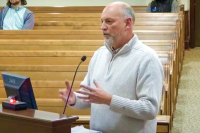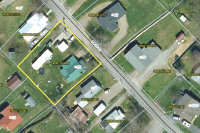Study says water, sewer needs rising
By Sarah Kucharski • Staff Writer
The state’s water, wastewater and stormwater systems are faced with $6.8 billion in capital improvement needs, a figure that is expected to reach $16.5 billion by 2030, according to a new study released by the North Carolina Rural Center.
The $2.5 million study — funded by Congress ($1.2 million), the Clean Water Management Trust Fund and the Rural Center ($500,000 each), and the state General Assembly ($300,000) — was designed to get an accurate picture of the state’s water resources and system infrastructure. The study focused on water supply, wastewater treatment and stormwater management.
The study is the second of its kind, the first of which was conducted in the 1990s. That study included 85 of North Carolina’s 100 counties and found $11.9 billion in unmet water and sewer needs in rural parts of the state, said Bill Gibson, director of the Southwestern Commission Region A.
Those findings resulted in an $800 million statewide bond for monies to be used for water and sewer projects, passed in 1998.
“That money’s now gone,” Gibson said.
Related Items
Despite the substantial contribution to statewide water systems, additional funds are needed to keep up with the growing demand, said Bill McNeil, a senior associate with the Rural Center.
The use of public water supplies continues to grow. Since 1970, usage has risen from approximately 450 million gallons per day to 925 million gallons per day in 2000, according to the study. The only sectors that have experienced a water usage decrease are industry, which is the result of high-capacity water users outsourcing their plants to foreign countries, and livestock/aquaculture, due to a cooling off of the once-booming hog market.
More than 93 percent of the state’s 515 water systems and more than 94 percent of the state’s 370 sewer systems are expected to grow over the next 25 years.
However, a problem exists in that only half of the state’s water systems have a capital improvement plan and know their capital needs for the next five years, a fact McNeil called “a bit of a shocker.”
Running a system without a capital improvement plan leads to difficultly receiving funding for expansion and improvement projects. And since hurricanes Katrina and Rita, construction costs are likely to rise for water and sewer infrastructure improvements.
“The cost of installing infrastructure probably went up 20, 25 percent in the last 12 months,” McNeil said.
In Jackson County, Tuckasegee Water and Sewer Authority Director Joe Klein said that the authority already is in the process of reevaluating its capital needs. In 2000, the authority estimated $8 million in capital needs over 10 years. That estimate already has increased to $20 million over 20 years, Klein said.
The authority soon will open bids to construct a building to house the authority’s new treatment plant — though the term “new” may be somewhat of a misnomer. The plant actually was purchased as a used piece of equipment from another water system.
In Franklin, where the town bears the brunt of providing water and sewer to the whole county, the study is not expected to have an immediate effect on system planning. The problem there isn’t finding out what’s needed, it’s finding the money to do it.
“We’re at the point where we’re going to have to expand both our treatment plants. It’s just a matter of which comes first,” said Mike Decker, Franklin town manager.
System operators must find a permanent revenue source to fund capital improvements — something other than passing on the costs to taxpayers, McNeil said. Nevertheless, many systems are not charging enough to meet their own costs.
For example, in the state’s 115 smaller systems registering 400 or fewer service connections in 2004, an average monthly increase of $41.25 is needed to pay for current capital improvement needs. The impact on larger systems is proportionally distributed. In the state’s 43 systems registering 10,000 or more service connections in 2004, an average monthly increase of only $10.25 is needed to fund capital improvement needs.









